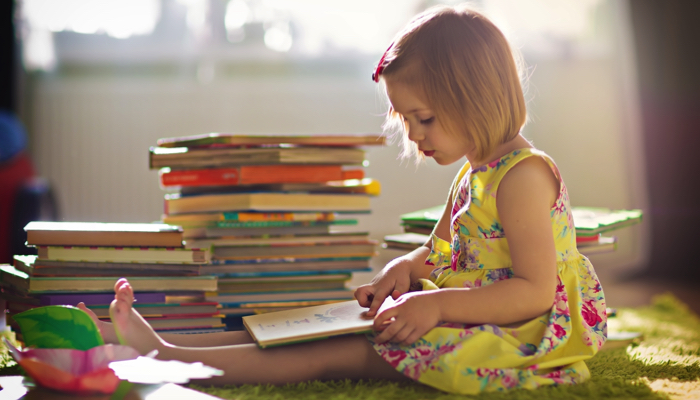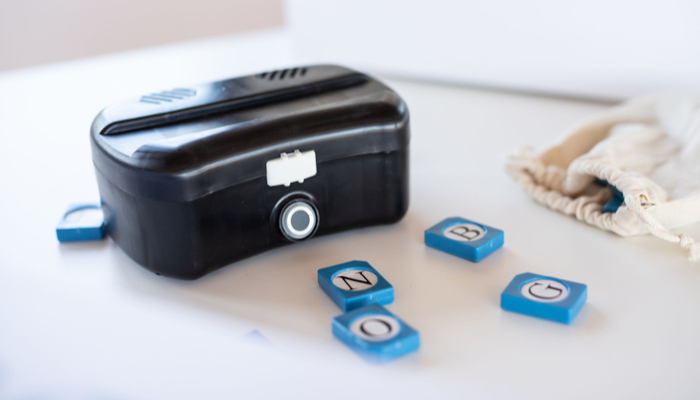Story Boxes: A Hands-On Literacy Experience

This post may contain affiliate links; please see our terms of use for details.
By Norma Drissel
A Story Box is simply a collection of items in a box or bag that corresponds to the items mentioned in a story. It is a way for young children with visual impairments to experience a story.
Educators have long emphasized the importance of tactual exploration i.e. hands-on learning for young children with Visual Impairments. This is important not just for future Braille readers who will be using their finely tuned sense of touch to discriminate letters and to decode words, but really for all young children so that they can take in information, build concepts, and further understand their world.
Purposeful exploration involves thinking and concept building. Children gather information through the experiences that they have. This is how they develop an understanding of how things relate. These experiences give meaning to their lives through the development of concepts. Literacy emerges from hands-on experiences for all children.
Important things to remember about story boxes
- Give your child lots of time.
It takes more time to figure out what an object or shape is through tactual exploration than through vision. A tactual learner needs to examine parts of an item separately then put the information they have gathered together to gain full understanding of the item. - Think beyond words on a page.
Words are just symbols representing ideas and concepts. Without meaning words are a series of disconnected sounds and letters. Hands-on experiences help to provide meaning to words. - Just do a little at a time.
You need not present all the items in a box with each reading. Determine your child’s interest and attention so as not to overwhelm her with stuff. - Share the story with others.
Get everyone in the family involved, including siblings. Share your story boxes with young sighted children. They are very popular.
Making a Story Box in three easy steps
 Books, Books Everywhere: Choosing a StoryWhen selecting a story for your child, choose one that is simple and talks about familiar objects and concepts. Story Boxes can range from very concrete hands-on topics to the more complex and abstract.Initially a box might contain items that your child uses during daily routines. You can make up a story about the routine or family activity. Your child may be the main character of your story. It can be about a trip to visit grandma, bath time or mealtime, a playtime with dad. In this case no book is really needed.
Books, Books Everywhere: Choosing a StoryWhen selecting a story for your child, choose one that is simple and talks about familiar objects and concepts. Story Boxes can range from very concrete hands-on topics to the more complex and abstract.Initially a box might contain items that your child uses during daily routines. You can make up a story about the routine or family activity. Your child may be the main character of your story. It can be about a trip to visit grandma, bath time or mealtime, a playtime with dad. In this case no book is really needed.
Variety is fun. Expose you child to different types of books. Feel free to adapt them, to make the book more accessible and interesting. Simple board books can be enhanced with Braille Dymo tape or a Braille Labeler. Twin Vision Books provide enrichment for siblings as well. Sound books can be made accessible by affixing a little texture to the spot one must depress to activate.
Choose books that have characters and items that are readily available. Remember the complexity of the story and the number of items presented should be suited to you child. Often simpler is better.
Also choose a story to match you child’s attention span. Short and sweet works well for young children. Choose a book that does not rely on visual experiences or pictures to provide meaning to the story. Choose books that are predictable and that have rhythm and rhyme.
- Getting It All Together: How To Actually Construct the Story Box
Begin with an appropriate book then select corresponding items. You may choose to go on a shopping spree but often collecting familiar objects from you household will do just fine.Place the book and items in a storage container. Although many folks us Zip-Lock bags or shoe boxes, sweater-sized plastic containers are preferable as they are likely to stack, thus affording you an opportunity to establish a story box “library”. They are also sturdy enough to bear up under the wear and tear of children’s hands. (Note: prying these boxes open is a beneficial activity which develops the hand strength needed to use Braille).Label the exterior of the container. A tactile marker will enable you and your child to “read” the title; e.g. three pieces of fake fur might be a good label for the story of Goldilocks and the Three Bears.
- Reading the Story
Handle the objects in the box one at a time giving your child lots of time to explore. Comment on the item’s size, its shape, its texture and name the item. Children with blindness benefit from an adult’s modeling the function of the item, so if it’s a spoon, pretend to eat. If it’s a mitten, try it on. Allow the child to explore freely. Compare items.
Children with blindness benefit from an adult’s modeling the function of the item, so if it’s a spoon, pretend to eat. If it’s a mitten, try it on. Allow the child to explore freely. Compare items.
After tactually exploring the items place them aside. Read the story and once again present the items as they are mentioned in the story. Avoid clutter. Too many items at once can be very confusing for young children with blindness.
When reading, have fun. Use sound effects and dramatic intonation to peak you child’s interest.
When you are finished with the story box put clear closure on the activity by having your child help place the objects back in the box, thus providing another opportunity to handle the objects.
Children can experience the same story box at many levels over time. Some children will want to handle the book and find the Braille on the page. Others will enjoy anticipating and identifying their favorite items, while still others will memorize the book and tell the story to the adult.
Some ideas for Story Boxes

Blueberries for Sal by R. McKloskey.
Contents: Large pail, small pail, berries to cover large pail bottom, (4) berries to clunk in small pail.
Jennifer’s Messes by Suzette Wright.
Contents: Cheerios, barrettes, (2) coins, comb, pencil, keys, doll purse, pretzel.
Goodnight Moon by Margaret Wise Brown. Available in print/braille from Seedlings.
Content: balloon (mylar), picture frame, three plush bears, doll house, furry mouse, bowl, plush kittens, mittens, toy phone, clock, socks, comb, brush, star shape.
Listen to the Rain by Bill Martin, Jr.
Contents: Tape of rain sounds, raincoat, boots.
Roly Poly Man by Suzette Wright.
Contents: Play Doh.
Strega Nona by Tomie de Paola.
Contents: Pasta, pot with lid, bowl, fork.
 If You Give a Mouse a Cookie By Laura Joffe Numeroff.
If You Give a Mouse a Cookie By Laura Joffe Numeroff.
Contents: Cookie, cup, mil container, straw, mirror, scissors, dust broom, sponge, blanket, pillow, crayons, tape, paper.
Suppertime for Frieda Fuzzypaws by Cyndy Skekeus.
Contents: Cookies, plate, cup, pasta, paper, crayon, paper cookie.
The Foot Book by Dr. Seuss. Available in print/braille from Seedlings.
Contents: Slippers, towels, cotton balls, toy clown, big shoes, small shoes.
The Jacket I Wear in the Snow by Shirley Neilzel.
Contents: Red wool hat and scarf, zippered jacket, sweater, boots, long underwear, socks, jeans.
The Little Engine That Could by Watty Piper. Available in print/braille from Seedlings.
Contents: Dolls, balls, toy engine, sailboats, toy animals, clown.
The Longest Noodle by Suzette Wright.
Contents: Noodle, fork, shoelace, jump rope, ribbon, yarn.
The Sweet Smell of Christmas by Patricia Scarry.
Contents: Cinnamon, pinecone, candy cane, spirit of peppermint, ginger, cocoa.
Related Posts

Braille and Literacy
Making Braille Fun: Introducing Handi Exceller’s Innovative Learning Tools for Blind Students
Handi Exceller was born from a simple idea: learning braille should be both fun and accessible. The company creates interactive and gamified ways to teach braille.

Braille and Literacy, Toys, Visual Impairment
24 Braille Toys for Kids Who are Blind
Everything from alphabet blocks to raised line coloring pages and activity books to puzzles to card and board games... and so much more! And it's all in braille ready for...

Braille and Literacy
5 Activities for Name-Writing
Learning to write your name is an important preschool skill. Make the task fun with one of these 5 activities for name-writing!